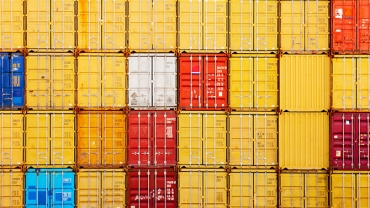
Who will benefit from the simplification of the PEM Convention rules?
20/12/21
The rules of origin for trade between Ukraine, the EU and other Contracting Parties of the Regional Convention on Pan-Euro-Mediterranean Preferential Rules of Origin (PEM Convention) will be simplified soon. This means that exporters will obtain more benefits from manufacturing products in Ukraine as the products will become more competitive in other markets, primarily in the EU, while importers will benefit from the reduced administrative burden, explains Alyona Kovalenko, Senior Associate of Customs Regulation and International Trade practice at PwC in Ukraine.
The PEM Convention has been in force in Ukraine for over two years. It was developed by the European Commission to align rules between various free trade agreements and simplify the determination of the origin of goods.
Today, Ukrainian businesses operate under the PEM Convention when they export to the EU, Georgia, Israel, Switzerland, Lichtenstein, Iceland and Norway or, vice versa, when they receive goods produced in those countries. This enables them to apply a reduced or even zero import duty rate and therefore to reduce the tax burden. Additionally, these rules will soon be incorporated in the free trade agreement between Ukraine and Moldova.
Changes in the rules of origin
The rules of origin under the PEM Convention will soon be amended for Ukraine. The amendments focus on reducing the administrative burden on businesses and increasing the volume of international trade.
The revised rules have already been approved by the European Commission and will come into effect once agreed between governments of the contracting parties to the free trade agreement. In Ukraine, the matter is now at the stage of interdepartmental approval. We expect that Ukrainian businesses will be able to enjoy the benefits of the revised rules in trading with the EU next year.
At the initial stage, exporters will be able to choose, which version (revised or previous one) of the PEM Convention is best suited and more beneficial for them to apply.
Advantages of the new rules of origin for Ukrainian businesses
Given the right preparation, Ukrainian businesses will be able to benefit from the following changes in the rules of origin:
Exemption from duty for most goods (except textiles)
Example. A company imports plastic connectors originating in China under the inward processing customs regime in Ukraine with an exemption from customs duties. Subsequently it uses the connectors to manufacture automotive spare parts, which obtain Ukrainian origin. Prior to export to the EU, under current rules, the exporter must pay customs duties and import VAT for the Chinese connectors. However, under the alternative rules, an exemption from such customs payments will be allowed.
Increase of the share of non-preferential materials in finished goods from 10% to 15% of EXW price or net weight of the goods
Example. A company uses Brazilian coffee to produce coffee beverages. The share of the coffee is 12% of the net weight of the mix. Under the new rules, a 0% duty rate will be applied for imports of such goods from Ukraine to the EU provided that other conditions are met. Moreover, for the goods for which the share of materials is calculated based on the value of goods, companies will be able to apply for customs authorisation to perform calculations based on average material prices. This will reduce the administrative burden by not preparing calculations individually for each shipment of finished goods.
The ‘direct shipment’ rule replaced by the ‘non-alteration’ rule
Example. Georgian goods are transported to Ukraine by sea with reloading in Turkey. Currently there is no FTA between Ukraine and Turkey, so usually the reloading was a problem for Ukrainian importers to confirm the preferential origin of goods from Georgia. The revised version of PEM Convention envisages a ‘non-alteration’ rule that should be a solution for such cases.
EUR-MED movement certificate replaced with EUR.1
Example. A company exports candles originating in Ukraine to Switzerland. If alternative rules are signed between Ukraine and the EFTA, the company will be able to provide a EUR.1 certificate to support the origin, i.e. the same certificate that is currently provided for the EU, instead of EUR-MED.
More flexible rules applied for segregated storage and recording of goods
Example. A Ukrainian company packages tea for export to the EU and for interim trade in Ukraine. Depending on the country of destination, materials originating either in the EU or China are used. New rules permit storage of such materials together at the warehouse without segregation provided that these are recorded separately and respective authorisation from customs authorities has been obtained.
Changes in rules relating to the 'sufficiently worked or processed’ criteria for certain goods
Example. A Ukrainian company produces fruit and vegetable juices (commodity heading 2009) and exports them to the EU. Under the revised rules, one of the conditions for 'sufficiently worked or processed’ is sugar content of less than 40% in the total weight of the product. However, currently the permitted sugar content is limited to 10% of the product value. Prior to applying the new rules, we recommend checking what changes will apply to your company's products.
The list of changes in the rules above is not exhaustive. Specifics are set out in each individual free trade agreement as agreed between the contracting parties and must be taken into account in application of the rules.
Preparing to apply the simplified rules of origin
The preparation should cover primarily the following:
identifying the purpose of application of the revised rules of origin and any related issues,
revising the 'sufficiently worked or processed’ rules,
analysing the current structure of the company’s processes and the tools under the revised PEM Convention.
The changes may relate to various areas of the company’s operations, such as the procurement of raw materials of other origin, preparation of documents for customs clearance, delivery and storage method, changes in the bill of materials in order to obtain preferential origin, the procedure for preparing calculations to support the origin of finished goods, new procedures for interacting with customs authorities.
Any operational changes should be preceded by a comprehensive analysis of the advantages and pitfalls of the new rules of origin taking into account the specific processes already in place within the company. This will help accurately evaluate the effort and outcome from the anticipated changes and prepare an action plan for their implementation.
The new rules of origin aim to develop regional trade by applying reduced import duty rates. The companies able to structure their operations right under the revised rules will achieve significant savings in operating costs and reduce their administrative burden, while the manufacturers will additionally receive more opportunities to enhance the competitiveness of their products in other countries and increase the volume of export.
The original version of this article was published on Ekonomichna Pravda in Ukrainian.









